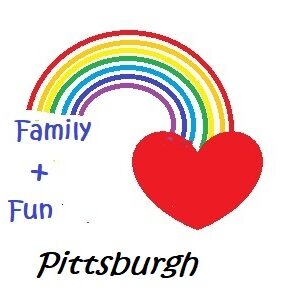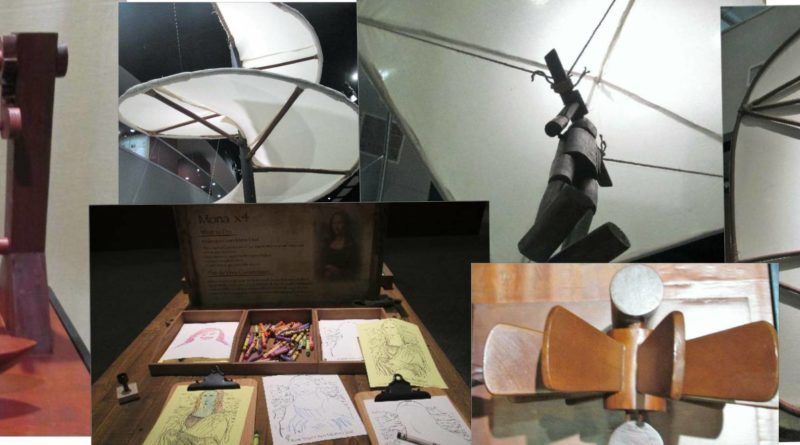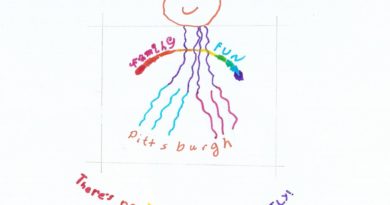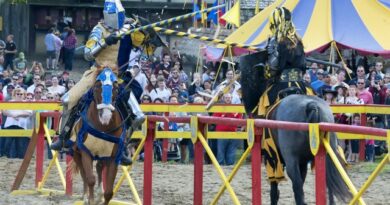da Vinci The Exhibition – a FamilyFunPittsburgh Know Before You Go Guide
by Janet Jonus
da Vinci – The Exhibition is at the Carnegie Science Center’ new PPG Science Pavilion, near the Rangos Theater. da Vinci explores the innovations, inventions, life, writings, and art of the Renaissance Master.
The entrance to the exhibition contains three panels describing the impact of the Renaissance on the past and present and the details of da Vinci’s early life. (da Vinci was from the town of Vinci, in the Tuscan region of Italy. The name “da Vinci” literally means “of Vinci”. Da Vinci’s mother was poor peasant, his father a wealthy notary. He was born “out of wedlock” on April 15, 1452 but his father accepted him as his legitimate son. da Vinci was raised in his father’s home and provided a basic education.) There is a large map of da Vinci’s life. The final panel describes da Vinci’s codices. The codices were collections of papers and books where da Vinci wrote down his observations, studies, ideas, and inventions. There is a small display with reproductions of the codices themselves.
da Vinci – The Exhibition is laid out in the Main Pavilion at the Science Center. More than 60 of DaVinci’s inventions have been created to exacting standards using DaVinci’s detailed drawings. Some of the inventions are labeled “Please Do Not Touch”, and some have a “Please Touch” sign on them.
The first Gallery highlights da Vinci’s exploration of Flight and Weather. da Vinci studied birds throughout his life to develop his ideas of manned flight. Reproductions of da Vinci’s Flying wings dominate the “skyline”. There is a United Wing and a Flying Machine. A parachute (and a wooden parachutist) floats in the air. A Vertical Ornithopter explores the concepts of vertical flight. Two Aerial Screws demonstrate the idea of using wind for propulsion. Guests can manipulate a Flying Wing that mimics the movement of a bird’s wing in flight. da Vinci invented an anemometer and an anemoscope to study the wind speed and direction. A wax Hygrometer measures the humidity in the air.
Gallery Two explores da Vinci’s studies in Physics. Many of the reproductions in this gallery are “OK to Touch”. Turn handles and explore how gears work. The Toothed Rack is a wooden version of the modern jack. See how ball bearings work. The Spiral Spring can be wound up as potential energy. When let go, the kinetic energy of the spring powers the handle. (da Vinci would use “spring energy” to power some of his other inventions.) The Lantern Gear Mechanism turns a lantern using gears. The Hammer with Eccentric Cam uses the asymmetrical cam gear to transfer energy to a wooden hammer, increasing the intensity of the blow of the hammer. A series of pulleys show how the pulley lets humans lift heavy weights with ease. The rolling mill was designed to press metal into thin sheets. The Chain Cranker is the precursor to the bicycle chain. Two large revolving cranes, used to lift and move heavy loads, are in the Do Not Touch category but they are fine examples of da Vinci’s innovation.
The Third Gallery is the Art Gallery. Da Vinci is one of the world’s best-known artists. Every piece of art has been reproduced in its actual dimensions. At fifteen feet by 29 feet, The Last Supper dominates the Gallery. There are reproductions of the Adoration of the Magi, The Virgin and Child with St. Anne and St. John the Baptist, The Baptism of Christ, Madonna of the Carnation, The Annunciation, Madonna Litta, The Virgin of the Rocks, and Virgin and Child with St. Anne. (A lot of da Vinci’s art was for religious orders who had the means to commission artistic works.) da Vinci’s Portrait of a Musician, Portrait of Ginevra Benci, La Belle Ferronniere, and The Lady with Ermine (a classic study of the use of light and shading in painting) are examples of da Vinci’s non-religious artwork. The portraits are excellent contrasts for the one piece of art most people want to see – The Mona Lisa. The Mona Lisa hangs on the gallery wall where you enter. It is smaller than most people think. The reproduction is beautifully done. While everyone knows you should never touch art (and you shouldn’t touch this Mona Lisa), it is a reproduction and in this exhibit allows you to get extraordinarily close to this most famous work. This was a favorite “selfie station” for guests at the Exhibition.
Should children quickly bore of the art (while the parents want to see more), the Art Gallery is also home to four Activity Centers created by the Science Center staff. The first center is based on the Mona Lisa. Families can make their own Mona Lisa by drawing it, using stamps, coloring in a Mona Lisa, or using a crayon-relief. Everyone can use their creativity to make their own work of art.
The Second Center is Take Flight. Families can use the templates and safety scissors to make their own paper helicopter.
The Third activity is Take the Wall. Guests use wooden catapults to propel balls over a fort wall. Can you find the perfect combination to succeed?
The Fourth Activity is Mirror Writing. da Vinci wrote everything in reverse (and sometimes in code). Some think he did this to maintain the secrecy of his discoveries, others point out da Vinci was left-handed and may have simply found writing backwards (andright to left) easier. Four mirrors are set up in front of chalkboards. Can you write in mirror image so you can read your codice in the mirror? (It is harder than it looks.)
The Fourth Gallery features da Vinci’s innovations in Hydraulics, Optics, and Musical Instruments. da Vinci’s interest in water resulted in many creations including the double-hulled boat, a submarine, a life preserver, a paddleboat, and a diving suit. He also designed a rotating bridge that could “open” to let boats pass through. Examples of da Vinci’s work in music include a reproduction of a double flute and a “portable piano”. da Vinci was very interested in optics and lighting. His interest married his scientific pursuits with his life as an artist. He was fascinated by the study of the human body and in the reflectivity of mirrors. The Room of Mirrors was a FamilyFunFavorite. Guests can enter the Room of Mirrors and study their images from all angles. There is another display exploring projection and two others exploring the inner workings of clocks.
The Fifth Gallery is home to da Vinci’s many inventions in warfare. In addition to his commissions for artwork, da Vinci was hired to protect Venice from the invading French army. da Vinci’s inventions reflect war as it was in his time through artillery improvements that would be at home in the early 20th century. The scythed chariot and the scythed wagon were designed to render infantry attacks ineffective. The assault ladder’s simple design could be easily replicated. There is a catapult and a covered assault bridge. da Vinci innovated many improvements on cannons and guns. He created a steam powered canon. His triple canon aimed to solve the problem of reload time during battle. The triple canon had three canons. One could be fired while the second cooled down and the third was reloaded. The three-tiered gun used the same principle, allowing the gun to be loaded and fired at the same time. Both of these innovations were precursors to the modern machine gun. The fan-type gun is one of the most impressive pieces in the Exhibition. The multi-gun, fan-shape allowed for a wide field of firepower to be used against advancing infantry. Kids will love the da Vinci tank. The gum drop-shaped tank was designed so it could be moved in any direction. It was covered with armor and had an array of guns that could shoot in all directions. The full-size tank is large enough for two kids to fit inside. (An interesting note: The tank design in the codice has a major flaw. The gear that would move the tank forward is drawn incorrectly. Some experts believe da Vinci did this on purpose so his design, if stolen, would not work.)
While many guests may duck out of the Exhibition at this point, there is even more da Vinci on the second level of the PPG Pavilion. The second level can be reached by a staircase within the exhibit hall or by elevators just outside the exhibit hall doors.
Gallery Six, on the second floor, is the Gallery of Anatomy. There are numerous reproductions of some of da Vinci’s many drawings of human anatomy, including a copy of the Vitruvian Man. (The actual size is very small, about 14” by 10”. (Vitruvian Man is reproduced as a large image on an adjoining wall. Warning for parents unfamiliar with Vitruvian Man. This is a drawing of a naked man, arms outstretched. It is a study of the proportions of the human body. As a trained artist, da Vinci would have studied human anatomy and movement.) Many of the drawings are detailed studies of human anatomy da Vinci made during his dissections of human bodies.
The Seventh and final gallery explores da Vinci’s contributions to civil engineering. da Vinci wanted to make improvements in daily life. One of his creations is an odometer, used for measuring distances. In a time when maps were not common, da Vinci created numerous maps. There is a large model of da Vinci’s Ideal City – laid out in square blocks instead of the haphazard design of many cities of his day. Most people will be interested in his self-propelled car, and will be surprised by the wooden bicycle tucked up against a wall.
Families will love the Activity Centers. The Build It! Activity Center has over-sized tongue depressors with small slits that can be used to build walls, forts, buildings, bridges, or anything the imagination can come up with. (FamilyFunPittsburgh thinks the Science Center should package these sticks and sell them!) The next Activity Center has wooden gears, pegs, and a pegboard. Kids can design their own gear structures by moving the gears into interlocking designs. The gears are held in place by the pegs. (The simplicity of the designs of these two Activity Centers, coupled with the endless design potential would have made da Vinci proud.) The final Activity Center is a Puzzle/Tangram Puzzle activity. Kids have to figure out how to fit puzzle pieces onto pre-printed diagrams then they are challenged to create their own puzzles.
There is a large wall that shows the concept of the Golden Ratio based on the 1509 book de Divina Proportione by Luca Pacioli and illustrated by Leonardo da Vinci. The book was highly influential in its exploration of mathematics, geometry, and the natural world.
As you exit the Exhibition, you pass through a small da Vinci Gift Shop. There are trinkets (key chains with the Mona Lisa), posters, books, and da Vinci science kits.
da Vinci – The Exhibition takes guests through the mind of a genius. The Exhibition has something for kids of all ages (and their parents). A walk-through of the Exhibition will take at least an hour but it would be easy to spend two to two and half hours with da Vinci.
The Basics
da Vinci – The Exhibition is in the PPG Science Pavilion at the Carnegie Science Center. da Vinci – The Exhibition requires a separate ticket from the General Admission to the Science Center. Tickets are sold for specific entry times to allow everyone the chance to see the exhibition at a leisurely pace. Tickets for da Vinci are $19.95 for adults 13+, $17.95 for seniors 65+, $15.95 for children 3-12, children 2 and under are free. If you want to enjoy the Carnegie Science Center, the Buhl Planetarium, the USS Requin (in season), and the Highmark Sports Works before or after your da Vinci visit, Combo Tickets are available. Combo Tickets for adults 13+ are $29.90, for seniors 65+ -$24.90, for children 3-12 – $21.90. Children 2 and under are free. da Vinci tickets for Members are $8.95. da Vinci – The Exhibition will be at the PPG Pavilion from February 16th 2019 through September 2nd 2019.
There are no bathrooms within the Exhibition halls. The closest bathrooms are on the Main Floor of the Science Center, and on the Ground Floor near the Rangos Giant Cinema.
Are you looking for more information about the Carnegie Science Center? Check out FamilyFunPittsburgh’s Know Before You Go Guide here: https://familyfunpittsburgh.com/carnegie-science-center-familyfunpittsburgh-ultimate-guide/
The Science Center is open daily from 1000AM – 500PM with some special summer hours. The Science Center is usually closed during Steelers home games and at some special events at Heinz Field. (The Science Center is across the street from Heinz Field.)
Admission to the Rangos Giant Cinema for any one educational movie (Hollywood movies are priced separately) is $9.95 for guests 3 and up. These tickets are available for sale online and at the Science Center. The Science Center offers combination discounts at the ticket counter (not available online). General admission to the Science Center and a Rangos Educational Movie is $27.90 for adults 13+. $19.90 for children 3-12, and $22.90 for seniors 65+. Children two and under are free.
You can also buy tickets to Laser shows at the Science Center. The cost is $8.00 for guests 3 and up. Admission to the USS Requin is $7.00 for all guests 3 and up.
Check out prices here: http://www.carnegiesciencecenter.org/visit/pricing/
There are several discounts to the Science Center. Discounts are available here: http://www.carnegiesciencecenter.org/visit/special-offers-and-discounts/
Parking is available in the Science Center lot for $5.00. Parking exit tickets can be purchased inside the Science Center at pay kiosks. They can be purchased at any time during your visit and used when you leave. The Allegheny Center T station is right next to the Science Center, and the Port Authority 14 and 18 buses stop nearby.
The Science Center is wheelchair accessible (except for the USS Requin). Arrangements can be made in advance for those with special needs. A limited number of motorized wheelchairs are available. The Science Center also has sunglasses and noise cancelling headphones for those on the autism spectrum and those with sensory disorders. Check here for more information: http://www.carnegiesciencecenter.org/visit/accessibility/
The Carnegie Science Center is at One Allegheny Avenue, Pittsburgh PA 15212 / 412-237-3400 / http://www.carnegiesciencecenter.org/



